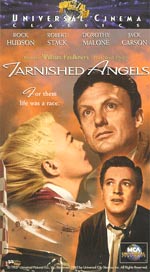|
| Tarnished Angels
taking off with Douglas Sirk, and friends.
|

| Philistin-ism.
The Friends of Rachel Worth. I may as well preface this with a little observation of my own. The album title seems to have thrown a few people, but it does possess an arch logic in keeping with the stars of earlier Go-Betweens efforts, the feline grace of Lee Remick, the knicker-free waspishness of Tallulah Bankhead and gun-toting Liberty Belle. Friends of Rachel Worth- surely that's a reference to Peter Yates' tired mid-70's gangster effort The Friends of Eddie Coyle. Featuring a bleary-eyed boozy Robert Mitchum, it stands poles apart from earlier Mitchum offerings, the sleekly groomed monochrome stylings of Build My Gallows High or Night of the Hunter. Fatness and bloatedness intervene where once was aloofness and economy of gesture. Aside from that, I hear Sleater-Kinney are featured- I remember Claire telling me about an album of theirs entitled The Hot Rock, after another tedious Peter Yates film, this one with Robert Redford, of Robert Forster haircare tips fame. After hearing snatches of the new album in a record shop, I haven't been tempted to persevere and buy it just yet. Call me a cultural imperialist, but on the basis of these references some of the magic would appear to have been tarnished in the intervening decade since 16 Lovers Lane.
|

| Professional-ism.
After Alistair's recent notes on Stuckism, I'm tempted to look for another -ism to pin my hat on. I've been hungrily watching again some old favourite films by Douglas Sirk, and I'm struck how apt that adjective would be to his working methods. King of 1950's soapy melodramas, Sirk deserves to be immortalized in song. A group like The Blue Aeroplanes in their early prime might have been potential candidates, able to conjure whirling dervishes of sound on stage, setting words in orbit like spinning tops around dancing bodies and multiple instruments. 'Breaking in my heart'- energies unleashed at breakneck speed, overwhelming forces made to dance on the edge of prejudice. They weren't afraid to sing songs about or by Tom Verlaine. 'Cowardice and caprice'- a voice in dialogue with itself, analyzing its motives and shutting off possibilities of unmediated, spontaneous action. Sirk's films operate in the void between those precarious states of being. There is a constant signalling of the aesthetic status of the film, the paintedness of the visual medium, despite film's pretence at "realism". There is nothing natural about the lurid Technicolor of Written on the Wind, or the snowscapes of All That Heaven Allows, with their resonances from Thoreau's unspoilt vision of nature in Walden. There's an unashamed literary basis behind the apparently sentimental plots and penny-dreadful dialogue. Those films are like fairy-tales, with the improbable happy ending element eviscerated. Instead characters are forced to build tentative connections between each other in the face of impossible adversity or impenetrable prejudice. Rock Hudson physically embodies the beefcake norm of 50's Hollywood masculinity, a desperate edifice of healthy chunkiness, a Charles Atlas faćade to offset the threat posed by the introverted ambiguity of James Dean, Sal Mineo or John Cassavetes.
|

| Isolation-ism.
The most daringly cinematic, and strangely literary, example of this technique must be The Tarnished Angels, freely adapted from William Faulkner's mighty Pylon, without interference from the author. Faulkner's novel conveys the dizziness of the aviator's or, come to think of it, racing driver's mentality. The love of speed for its own sake, the oneness of man and machine as a refuge from the slow-footed plod of life on ground level. Adrenaline pulses through both novel and film at an alarming rate. As mechanic Jack Carson says to pilot Roger Shumann, played with utterly convincing teeth-gritting intensity by Robert Stack, "I'll turn the screws and you'll turn the pylons". For those who know Stack only through his amusing portrayal of the embattled ground controller Captain Kramer in the spoof Airplane!, it's time to become acquainted with his earlier incarnation of breakneck airborne thrills. Dorothy Malone is given free rein by Sirk to shape her role as the romantic pawn in a melodrama that hollows out family values. Her defiant parachute jump before the crowds, calculated to draw attention to her legs and skirt, is undercut by the fabulous mechanic robotic loudspeaker commentary. This doubly underscored focus on her status as a flying woman becomes a sharply snide rebuttal of the male-oriented gaze. Similarly Written on the Wind featured one of the great death scenes in cinema, Malone dancing a furious mambo alone in her fiery red dress while her rich oil magnate father succumbs to a heart attack. Pylons themselves play a crucial structuring role in the film- quite how Faulkner managed to sell any copies of a novel named after a towering metallic construction during the height of the Depression I can't fathom, but the name carries with it the desolation and rootlessness of the times. How an unmoveable pylon can conjure up rootlessness may appear paradoxical, but how many people did you last see gathered round a pylon?
|

| Nihil-ism?
There's a brutal sense of realism which seeps through every frame of Sirk's most accomplished films, i.e. those which suffered least interference from external forces. The epigraph to Jon Halliday's Faber and Faber conversation book with Sirk is the following gem taken from the aging director's lips, when his own eyesight was failing by cruel irony: 'We had just passed the surgery of a doctor whose name was Metzger. "You know what that name means?" Sirk said to me, with a chortle. "Butcher- and that's what they often are."' The all-pervading sense of failure that accompanies attempts at romantic entanglement in All That Heaven Allows or Interlude, for instance, doesn't necessarily entail a self-consciously gloomy pessimism per se. Even Magnificent Obsession, with its focus on blindness and speed, Rock Hudson's playboy sacrificing his luxury lifestyle for the sake of an impossible romance, features enough intentionally comic exaggeration in the mise en scene to refute accusations of knowing negativism. What's magnificent and to be celebrated without hesitation is this peculiar combination in Sirk's work. Sirk's smirk, rather than any lip service to fashionable chic. What disappointed me most about Wong Kar-Wai's new film In the Mood for Love is the shortfall between its need to present itself as a lavishly packaged dramatization of yearning for a grand, unconsummated passion in the cinema and an obtrusive claim to signal a political subtext. There have been some very gratuitous comparisons thrown about between it and Sirk's methods, but style in the Hong Kong director's work here suffocates any attempt at social comment. More a very convincing Sunday supplement from the 60's, complete with faded colours and the ubiquitous Nat 'King' Cole serenading us in Spanish on the soundtrack.
|

| Image-ism.
How do we trust the surface image? This question is thrown up time and time again by Sirk. In the final race towards death and destruction which the camera tracks with elaborate movements in The Tarnished Angels, there seems to appear a graphic tensing and flexing of the power of visual precision to stimulate the senses and shock the viewer into quiet thought. Hence the irreducible majesty of the pylon, the whirring intensity of the propellor scything through the air, blade against blade of the competing (blue? I can't tell) aeroplanes. Filmed in unforgiving black and white and using the CinemaScope frame to exploit the panoramic sweep of the aviator's horizontal vision, the two-dimensionality of most films gives way to a serpentine coil. Sirk's titles jolt the viewer into pondering these wider elements of his vision- the image as an imitation of life, a phantasy that probes the recesses of the mind and turns up all manner of content and discontent. Camera movement and propeller movements are as consumed by fragility and uncertain impulses as the dysfunctional lives of the landlocked characters. Jerky versions of a dream, the succession of images jar with our unconscious need for continuity and escape, acting more as stopovers, strange interludes, brief encounters with equilibrium before the traumatic rupture takes over.
As a footnote, anyone who can name the film where Tallulah Bankhead refused to wear knickers on-set deserves a trivia prize of some kind…
© Marino Guida2000
|




